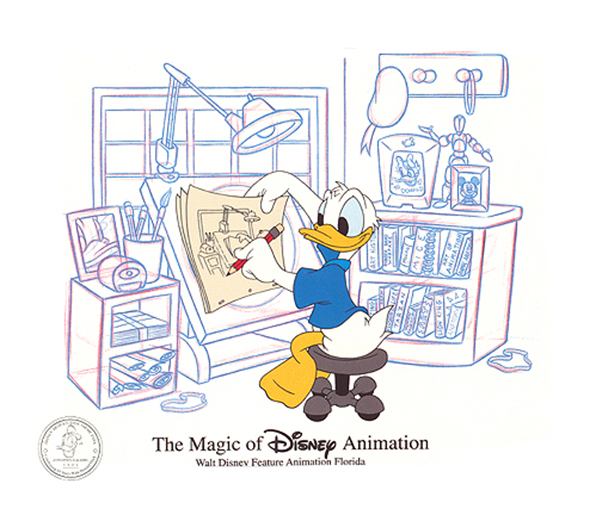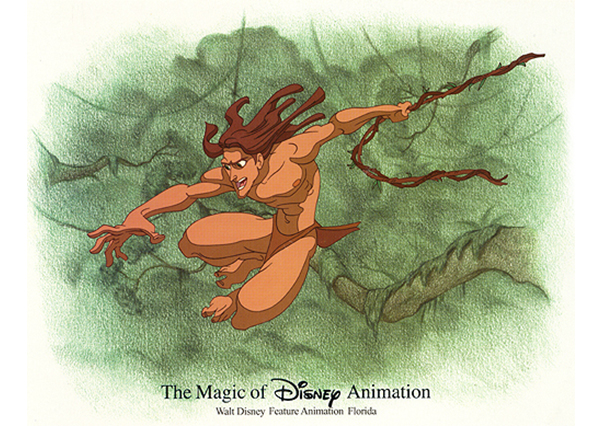To Cel or not to Cel
After my temporary assignment as an Animation Artist ended in the fall of 1996, I had the incredible opportunity to transition to a small but unique team within feature animation called Ink and Paint. For those who may not know what a cel is, cel is short for celluloid. A transparent sheet of plastic made out of celluloid was used to transfer the drawings that made an animation frame. The lines were inked by hand usually on the front of the cel (before the invention of the xerox machine), while the back of the cell was filled with cel vinyl paints of different colors that made up the character movement of the scene.
I quickly realized that building positive relationships was a winning quality to help achieve my dreams. Coincidentally enough, a prior supervisor was married to the manager in charge of the ink and paint team at that time and was able to connect me with her in order to test for the position.
I had never painted an animation cel other than the paint by numbers cels that Disney sold at their stores, but what truly helped in landing the job was the drive and personality that I brought to the summer assignment as an Animation Artist, a job that took me out of my comfort zone every day. Imagine an introverted and private person, describing the animation technique to a group of strangers. That was my first artistic job, and what I did on a daily basis as a group after group walked through the Magic of Disney Animation tour, at the Disney MGM Studios (presently called the Disney Hollywood Studios). Amazingly, a surprising extrovert side of me came out in my presentations. This job in particular offered me an animation internship with the studio that prepared me to answer any question that our visitors would have about the process of animation. The internship also exposed me to many artists and animation professionals that shared their talents and experiences with me.
I passed the ink and paint test and quickly initiated my permanent position with Ink and Paint. This was especially exciting at that time because this meant that I would be part of the "Show" in the Animation Tour. At that time, the ink and paint area along with other departments sat in an area coined "the fish tank" where visitors to the Animation Tour could see the artists at work behind large glass windows. The Ink and Paint section included a backdrop of paint glass containers of all the paint colors we'd ever used. There were 4 rows of 2 animation desks per row that filled the space. The team consisted of about 5 to 6 artists, not all at one time.
A view of the Ink and Paint studio desks from the audience side of the animation tour back in early 1997. Getting used to wearing gloves to paint cels was quite necessary to keep the cels from fingerprints, scratches, and dings.
I remember being aware of how distracting and often entertaining the view of the audience was behind the glass. Waving at the tour visitors behind the glass was a daily event, in addition to the constant glare of the flashes that seemed to bounce from one glass surface to the other around the studio from guests taking photos with flash.
Of course, the job was not all fun, it was actually quite extensive. There is a specific process in which animation cels are painted. Light cotton gloves are required to paint cels in order to keep the cels clean from hand dirt and oils. The darkest colors are applied first, lightest colors last. So if I was painting a cel with Mickey Mouse on it, the first color to be applied is black on 8 to 10 cels laid out on various drying racks positioned in front of the desk. Then one returns to the first cel painted and the next color is applied, let's say red. The red would be applied to all the cels, and so on until all the areas of the character art are filled. While our cels had pre-printed lines on the front; for limited edition cels, lines often were applied by hand, an extremely difficult task that only a few artists were able to accomplish.
Daily cel quotas needed to be fulfilled, which depended on the cel type that was being painted. I was lucky to come into the team when the first cel available to the consumer was still being painted. It was called Animator Mickey, a beautiful animation cel of Mickey sitting at an animation desk. Because the cel was so popular, we had to paint this cel at least one day a week in a round of 8 to 10 cels at a time in order to keep inventory. While it was not the hardest cel to paint, it was still challenging because the areas of paint needed were rather large and knowledge of the consistency of the paint was necessary to understand how much time one truly had to paint the surfaces before creating dry lines within the spaces that were visible on the front of the artwork.
We also painted two compositions that had very small Mickey Mouse poses that had an important connection to the studio, they were the Traveling Mickey (as pictured on the photo above behind my head) and the Climbing Mickey (a re-creation of the statue that welcomes guests into the Animation Courtyard area outside of the Animation Gallery. The Traveling Mickey was inspired by the animation tour itself. Throughout the original animation tour, guests were able to see a Mickey in different positions and levels of execution that would explain the animation process in the simplest way. Therefore, the animation cel was composed of three Mickey's that were printed on an animation background, while the last two Mickey's would be printed on a cel and painted by the artists. This cel was quite difficult to paint because of the small character size.
As the studio saw opportunities in celebrations and character popularity, a Donald at the Animator desk was launched, later followed by a Millennium Mickey cel that was only available in the year 2000.
Besides painting in the studio to keep a healthy inventory, we also painted "on stage." This meant that on one or two days a week, we would work at the animation gallery painting cels in front of our park guests. It was fulfilling to speak with people from all over the world that was just in awe of the work I was doing at the studio. It was truly an honor for me to represent the studio while on stage and it’s an experience I will never forget. People would just stand in front of me sometimes for hours just looking at how I painted cel after cel, and explained the process.
I also had the amazing opportunity to create a watercolor background for a very special cel in my heart called Friendship in Bloom. The cel was created exclusively by the animation ink and paint team to celebrate the release of Disney's Mulan, which was made entirely at the Florida studio. I was also able to create the limited edition stamp that was heat-transferred onto the cel to commemorate the film and cel released in 1998. This was actually the first piece of graphic design I ever created for Disney and an important step toward the future of my career in design.
The last cel I painted before leaving the Ink and Paint department was the Tarzan cel back in 2001. It was an incredibly dynamic cel that was very popular among collectors and animation art enthusiasts. By the time I left the studio, I had already been exploring a new path in my career in graphic design but I think that I became a better designer thanks to all that I learned while working at the studio that included attention to detail and thinking outside of the box.





